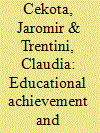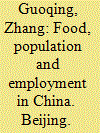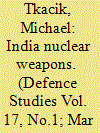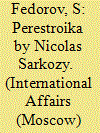| Srl | Item |
| 1 |
ID:
139269


|
|
|
|
|
| Summary/Abstract |
This article investigates the educational attainment, employment and living conditions of young Roma adults in Bulgaria, Hungary and Romania with the aid of national generations and gender surveys and other sources of information. It shows that in spite of a small improvement in the educational attainment of young Roma in comparison to the generation of their parents, the educational achievement and employment gaps have increased considerably during the post-communist period. The article also compares living conditions of the Roma with other population groups. It concludes with a discussion of policy challenges.
|
|
|
|
|
|
|
|
|
|
|
|
|
|
|
|
| 2 |
ID:
112637


|
|
|
|
|
| Publication |
Beijing, Foreign Languages Press, 2006.
|
| Description |
127p.
|
| Standard Number |
7119044680
|
|
|
|
|
|
|
|
|
|
|
|
Copies: C:1/I:0,R:0,Q:0
Circulation
| Accession# | Call# | Current Location | Status | Policy | Location |
| 056464 | 303.951/GUO 056464 | Main | On Shelf | General | |
|
|
|
|
| 3 |
ID:
151398


|
|
|
|
|
| Summary/Abstract |
This article argues India is laying the foundation to move away from “no-first-use” (NFU) as its nuclear weapons employment policy. Since the inception of its nuclear weapons program, India has claimed NFU as the centerpiece of its nuclear strategy. But India has a history of developing foundational changes to its nuclear weapons program before such changes actually occur. For example, the infrastructure of India’s nuclear weapons program was already being created in the 1950s under the guise of civilian nuclear power. Similarly, the weaponization of India’s program, which did not officially occur until after the 1998 tests, had its genesis in far earlier decisions. A close examination of trends in India’s nuclear weapons production complex, its delivery systems, and its command and control complex all lead to the conclusion that India is laying the groundwork for more flexible employment options, up to and including first use. This article does not argue such a decision has been taken. Rather, it argues the underpinning is in place to allow for a move to more flexible options, perhaps very quickly, at some point in the future. This could occur during crisis or it could occur incrementally over time.
|
|
|
|
|
|
|
|
|
|
|
|
|
|
|
|
| 4 |
ID:
102013


|
|
|
|
|
| Publication |
2010.
|
| Summary/Abstract |
THREE YEARS out of five at the helm is not enough to sum up yet three years of Nicolas Sarkozy have stirred up the public and the analytical community enough to justify a summary. Why?
|
|
|
|
|
|
|
|
|
|
|
|
|
|
|
|